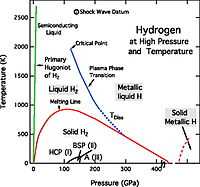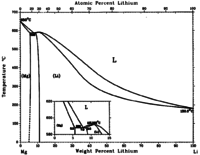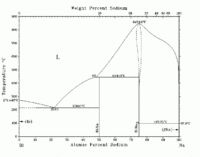Minerals/Metals/Alkalis
< Minerals < MetalsThe alkalis, or alkali metals, are the group 1 elements of the Periodic Table. In addition to the true metals: lithium (Li), sodium (Na), potassium (K), rubidium (Rb), caesium (Cs), and francium (Fr), hydrogen (H) is usually included.
Each of the elements in group 1 has or may have native mineral occurrences on Earth or elsewhere nearby.
Hydrogens

Native hydrogen is not known to occur on the surface of the Earth. As the pressure-temperature phase (PTP) diagram for hydrogen on the left suggests there can be solid metallic monatomic hydrogen and solid H2 at cryogenic temperatures and pressures, including room pressure or atmospheric pressure.
Solid hydrogen (H2) occurs in a hcp structure transitioning to a broken symmetry phase (BSP), then to the A phase at atmospheric pressure with increasing temperature.
Lithiums

As indicated in the magnesium-lithium phase diagram on the left, lithium occurs in the same crystal structure at lower temperatures as it does up to melting temperature. This is the bcc phase (α-Li).
"Native lithium is rare in nature. Most of the lithium is extracted from the mining [of] spodumene."[1]
Lithiophosphates
Lithiophosphate has the chemical formula Li3PO4, with 37.5 at % lithium.[2]
Sodiums

The phase diagram on the left shows bcc (α-Na) at higher temperatures up to melting and hcp (β-Na) with decreasing temperature below the transition at 97.8°C.
Native sodium does not appear to occur on the surface of the Earth.
Halites
USGOV.jpg)
Halite (NaCl) is probably the most common mineral containing sodium at 50 at %. It is a cubic mineral usually found in arid locations on Earth. Occurrences have clear, white, purple, blue, yellow, orange, and red varieties.[2]
Villiaumites
Villiaumite has the chemical formula NaF, with 50 at % sodium.[2]
Potassiums
.png)
As indicated in the phase diagram on the left, potassium occurs in a bcc (α-K) phase from room temperature up to melting.
Native potassium does not appear to occur on the Earth's surface.
Rubidiums
.png)
The pressure-temperature diagram on the left shows that rubidium is bcc (α-Rb) from room temperature through melting.
Native rubidium does not appear to occur on the Earth's surface.
Caesiums
.png)
As the temperature-pressure diagram on the left shows, caesium (formerly cesium) is bcc (α-Cs) from room temperature up to melting.
Native caesium does not appear to occur on the surface of the Earth or the Moon.
Franciums
Francium is bcc at room temperature.
Research
Hypothesis:
- Alkalis, or alkali metals, are the most reactive metals in the Periodic Table.
Control groups

The findings demonstrate a statistically systematic change from the status quo or the control group.
“In the design of experiments, treatments [or special properties or characteristics] are applied to [or observed in] experimental units in the treatment group(s).[3] In comparative experiments, members of the complementary group, the control group, receive either no treatment or a standard treatment.[4]"[5]
Proof of concept
Def. a “short and/or incomplete realization of a certain method or idea to demonstrate its feasibility"[6] is called a proof of concept.
Def. evidence that demonstrates that a concept is possible is called proof of concept.
The proof-of-concept structure consists of
- background,
- procedures,
- findings, and
- interpretation.[7]
See also
References
- ↑ Shanghai Xuanshi Machinery Co., Ltd. (2011). "Xuanshi". Shanghai, PRC: Shanghai Xuanshi Machinery Co., Ltd. Retrieved 2015-08-22.
- 1 2 3 Willard Lincoln Roberts, George Robert Rapp, Jr., and Julius Weber (1974). Encyclopedia of Minerals. 450 West 33rd Street, New York, New York 10001 USA: Van Nostrand Reinhold Company. pp. 693. ISBN 0-442-26820-3.
- ↑ Klaus Hinkelmann, Oscar Kempthorne (2008). Design and Analysis of Experiments, Volume I: Introduction to Experimental Design (2nd ed.). Wiley. ISBN 978-0-471-72756-9. http://books.google.com/?id=T3wWj2kVYZgC&printsec=frontcover.
- ↑ R. A. Bailey (2008). Design of comparative experiments. Cambridge University Press. ISBN 978-0-521-68357-9. http://www.cambridge.org/uk/catalogue/catalogue.asp?isbn=9780521683579.
- ↑ "Treatment and control groups, In: Wikipedia". San Francisco, California: Wikimedia Foundation, Inc. May 18, 2012. Retrieved 2012-05-31.
- ↑ "proof of concept, In: Wiktionary". San Francisco, California: Wikimedia Foundation, Inc. November 10, 2012. Retrieved 2013-01-13.
- ↑ Ginger Lehrman and Ian B Hogue, Sarah Palmer, Cheryl Jennings, Celsa A Spina, Ann Wiegand, Alan L Landay, Robert W Coombs, Douglas D Richman, John W Mellors, John M Coffin, Ronald J Bosch, David M Margolis (August 13, 2005). "Depletion of latent HIV-1 infection in vivo: a proof-of-concept study". Lancet 366 (9485): 549-55. doi:10.1016/S0140-6736(05)67098-5. http://www.ncbi.nlm.nih.gov/pmc/articles/PMC1894952/. Retrieved 2012-05-09.
External links
![]() This is a research project at http://en.wikiversity.org
This is a research project at http://en.wikiversity.org
| |
Educational level: this is a research resource. |
| |
Resource type: this resource is an article. |
| |
Resource type: this resource contains a lecture or lecture notes. |
| |
Subject classification: this is a Geology resource. |